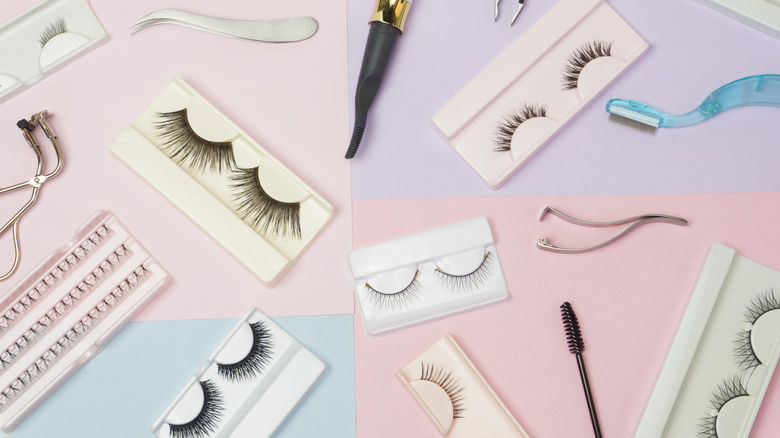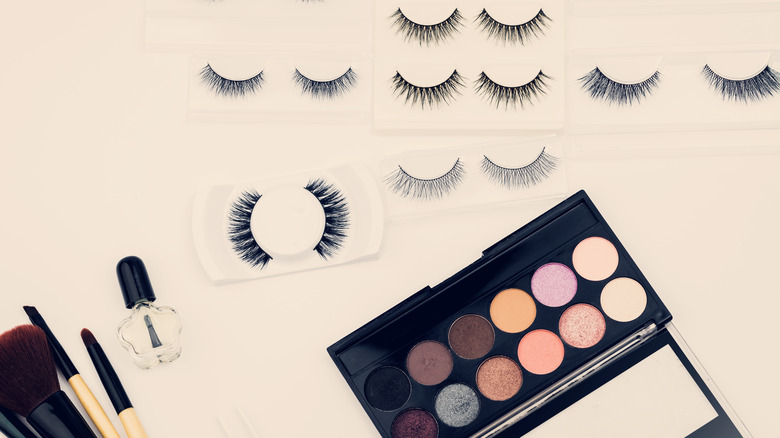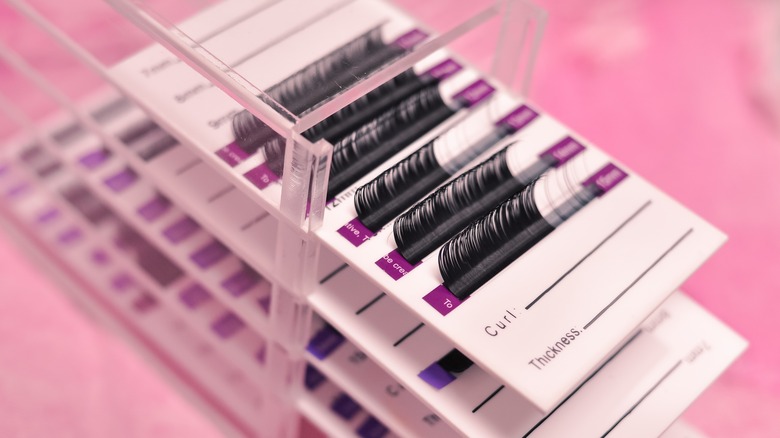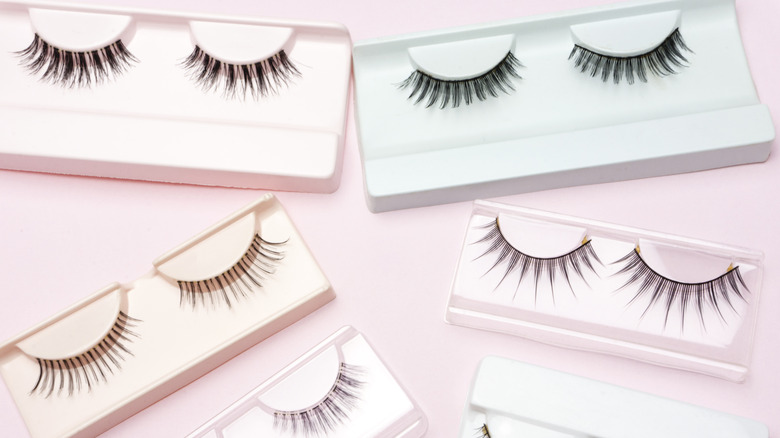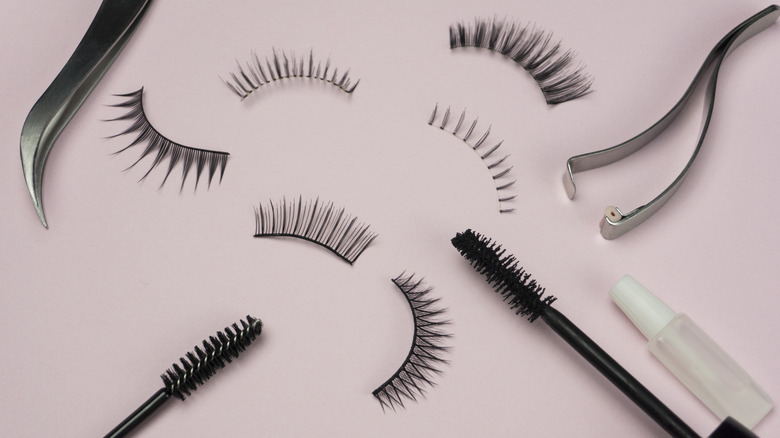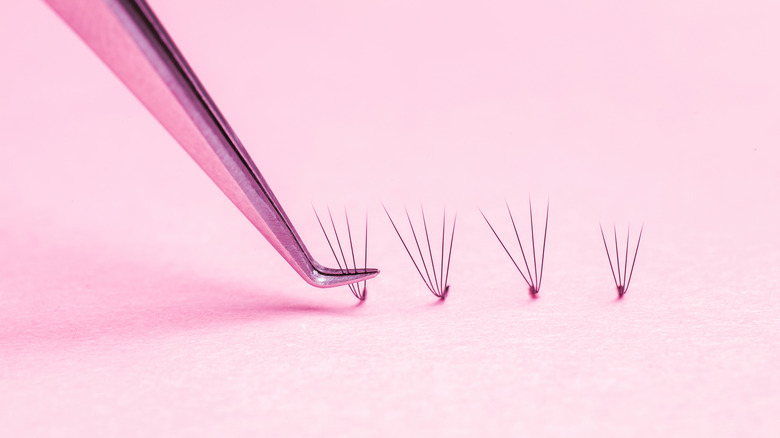How To Choose The Right Material For Your False Lashes
If a fallen eyelash necessitates making a wish, taking off a set of falsies must bring some serious good luck. False lashes are the icing on the cake for any makeup look. They draw attention to your eyes, elongate the appearance of your natural lashes, give you a bolder lash line, and can even make you look younger too. Opting for falsies instead of lashings of mascara even helps to keep your natural lashes healthier, according to Courtney Lutkus from StyleInGo (via She Knows).
And, obviously, the basis of any great eye look is healthy lashes. Founder of the beauty, cosmetic, and personal care brand Loveseen Jenna Lyons said it best: "Wearing lashes makes me feel a little more special" (via Elle). The right pair of lashes can make you feel like every day is your birthday. But different types of falsies, made from various materials, can change how they impact your appearance. Luckily, we're here with the breakdown so you can choose the right style for you.
Mink fur
The most popular type of lash is definitely the mink, whose name comes from the cutest semi-aquatic predator you'll ever see. As beauty and makeup expert Billie Gene explained to Makeup.com, "Mink lashes are the most luxurious false lashes." Since they are made from natural fur, mink lashes offer a soft, realistic, and fluffy look. There are vegan mink lashes that are made from synthetic fibers, too, although brands using real mink fur emphasize their cruelty-free approach to gathering the hair.
The soft, fine, and lightweight fibers help make them indistinguishable from your own eyelashes. Falsies brand Leida Lash recommends mink lashes for a natural, high-quality look. You can enjoy high-grade lashes and go bold with 3D mink, too. This style groups the mink hairs into bunches for a dramatic and voluminous effect. For a more subtle look, try individual mink lashes. These single-strand hairs allow for more precision styling. Mink lashes are expensive, but if you're on a budget, there are some fabulous alternatives.
Synthetic fiber
Similar to vegan mink, synthetic lashes are made from plastic fiber, as the cosmetic company Creative Soul notes. These lashes are cost-effective, but obviously don't just opt for the cheapest synthetic pair you can get because, often, they can be uncomfortable and only allow for a few uses before needing to be replaced. However, there are plenty of well-made synthetic lashes that are soft, durable, and cost-effective too.
The plastic material synthetic lashes are composed of gives the hairs a shiny finish. This gloss emphasizes the falsehood of the lashes. So if you want a super natural finish, these aren't the falsies for you. Another downside is the weight. These plastics are heavier than other fibers and can weigh down your natural eyelashes.
However, the eyelash extension specialists at Lady Lash point out that the material makes synthetic lashes stronger than some of their competitors and allows them to hold their curls better too. If you only wear fake lashes for the occasional night on the town, there's no harm in indulging in synthetic ones every now and then.
Human hair
It doesn't get much more realistic than human hair lashes. They're quite literally the real deal. However, if statement lashes are your thing, you may be out of luck with this style. It's harder to achieve much dramatic uplift with human hair falsies. According to Elite Daily, they do not hold the curl as well as synthetic fibers. Human hair lashes are ideal for a natural look, though, like when you just want the extra length or fullness without using too much mascara.
These lashes go through the same process as hair extensions made from human hair. Otherwise, this type of fake lash falls somewhere between mink and synthetic. They're thinner and more flexible than synthetic fibers but thicker and sturdier than mink hairs, as Teach Lashes confirms. The soft strands make them quite comfortable to wear, which is perfect for newbies to the false lash club — especially those who don't want to go too over the top just yet.
Faux silk
Silk falsies are designed to give your natural eyelashes additional wispy, light, and shiny hairs. Eyelash salon Lash Pilot clarifies that despite the name, sadly they're not actually made from 100% silk. There is some silk present, along with cashmere and plastic fibers. Faux silk lashes are typically tapered. The thicker base transitions into thinner ends, which creates their fluttery appearance. Silk lashes don't beat out mink or human hair in regards to the most natural-looking falsies, but they fare slightly better than synthetic.
Stacy Lash recommends these types of lashes for those with naturally thin or fine hair. The silk hair will blend perfectly and won't weigh down your existing eyelashes. Like human hair lashes, they don't lend particularly well to dramatic looks but instead are lightweight, long-lasting, and flexible enough for daily wear. Silk falsies are the go-to lashes for soft glam, and they also tend to be less expensive than the mink and human hair varieties. Overall, these lashes provide the best bang for your buck.
How to expertly apply false lashes
With lashes in hand, now comes the more tedious part — application. However, meticulous doesn't mean impossible. We have plenty of tips for a doable DIY application. First things first, always curl your natural lashes. Professional makeup artist Cher Webb asserts that this initial step will help meld your eyelashes to the faux strip for a more polished look overall (via Elle). Invest in a good eyelash curler for the best results.
Before picking up your adhesive, check if the falsies are an even length to your natural lashes. It is perfectly fine and often necessary to trim off any excess strips, so don't be shy. Next up is the glue and placement. Evenly apply the adhesive to the lash and allow it to dry for a few seconds. Then, set the strip on your lash line using some tweezers or just your fingertips. Looking down into a mirror will give you the best angle.
Finishing off with mascara is crucial, too, even if it may seem unnecessary. Celebrity esthetician Sarah Akram informed Byrdie that this step is vital "in order to create a seamless blend between your natural lashes and the falsies." After a few coats of your favorite mascara, step back and marvel at your lash work. Whichever style of falsies you choose, you'll be ready to shine.
